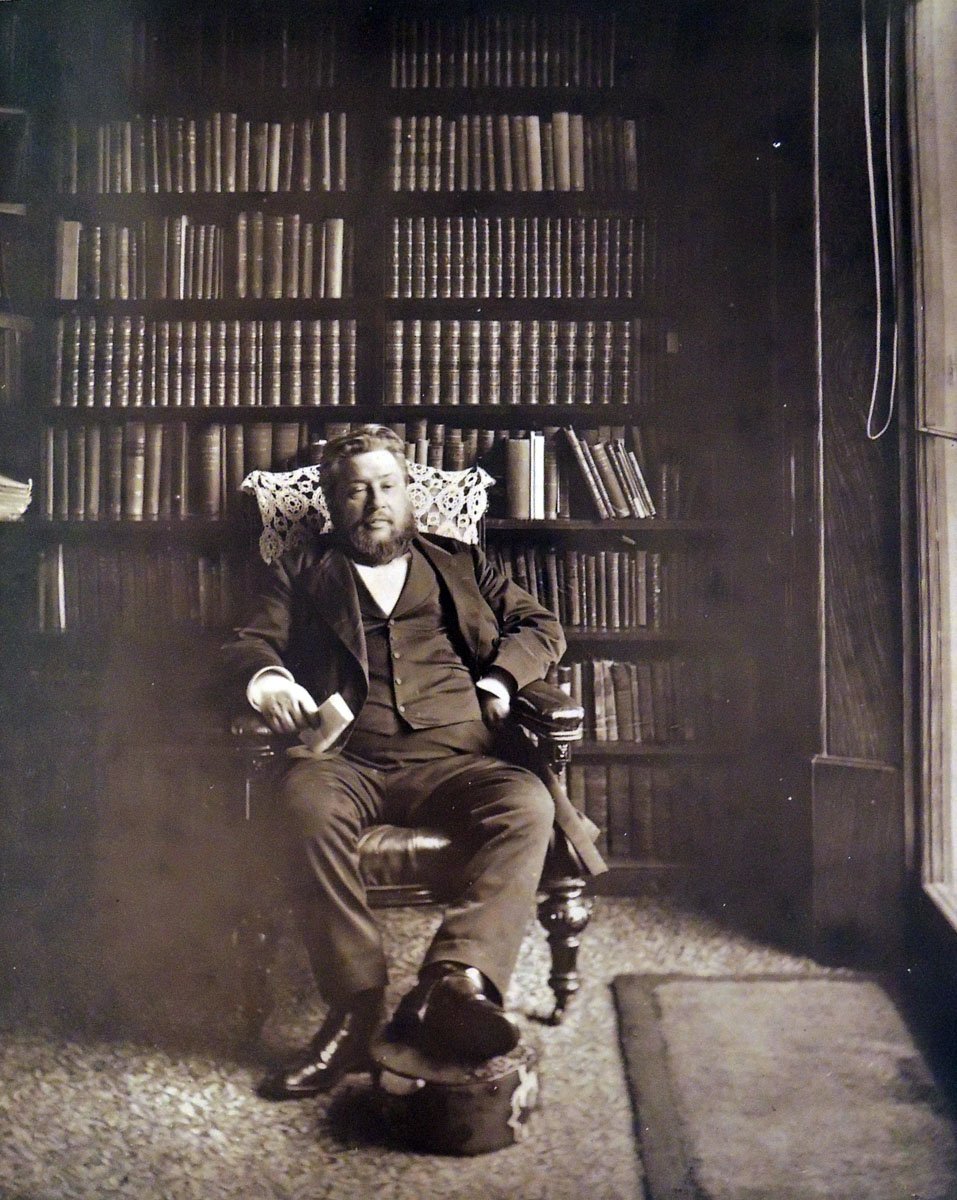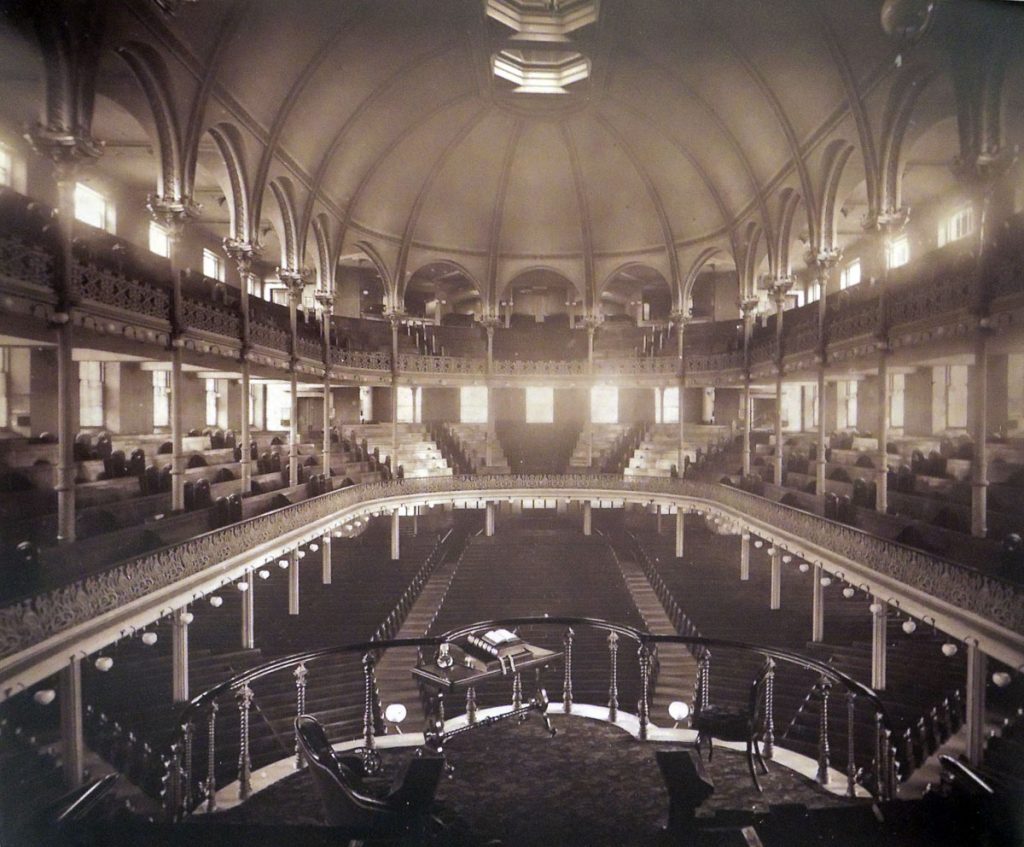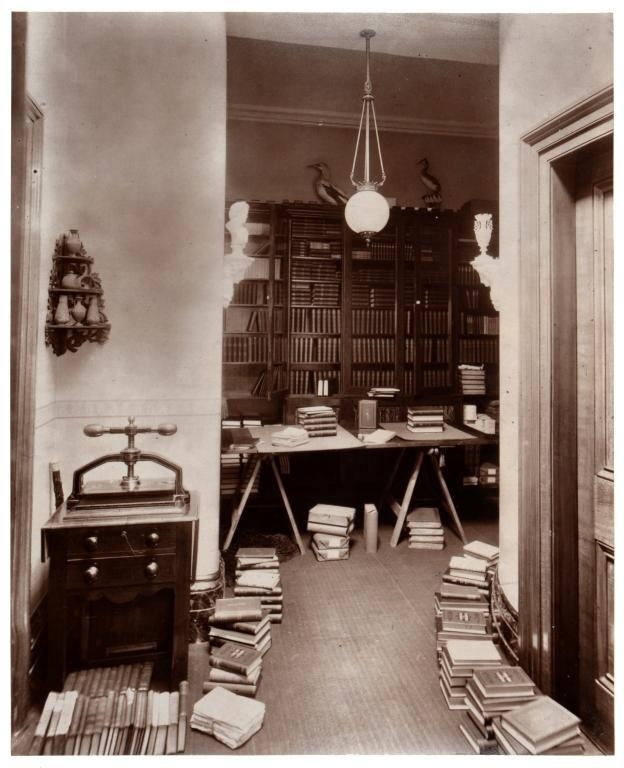Charles Spurgeon resources
Recently I've returned to the habit of reading a book before bedtime and when eating on my own, leaving aside the digital device and focusing my attention on the printed page. In the past few weeks I've finished Calvin Coolidge's autobiography, Arnold Dallimore's biography of Charles Haddon Spurgeon, a short book collecting Spurgeon's controversial writings calling attention to theological liberalism among British Baptists and Congregationalists (known as the "Down-Grade Controversy"), and started into The Federalist Papers, with an introductory essay by Garry Wills.
 Charles Haddon Spurgeon in his study, 1882, age 48
Charles Haddon Spurgeon in his study, 1882, age 48Charles Haddon Spurgeon (1834-1892) might be considered the first of the megachurch pastors. A Baptist of Calvinist convictions, he was gifted with a prodigious memory, a quick verbal wit, and, most importantly, a godly heritage by way of his grandfather and father, both Independent (Congregational) ministers of the Puritan persuasion. He began at age 16 as preacher and pastor of a Baptist chapel in Waterbeach, Cambridgeshire, then was called to serve as pastor of the historic New Park Street Chapel in Southwark, in greater London, at age 20. His congregation quickly grew to thousands, overflowing the building, requiring a move first to Exeter Hall in the Strand while the church was being enlarged, then to the Surrey Gardens Music Hall, and ultimately to a new facility, the 6,000-seat Metropolitan Tabernacle near Elephant and Castle in Newington, now in the London Borough of Southwark. In addition to preaching twice on Sunday and on other occasions through the week, Spurgeon edited and wrote essays and book reviews for a monthly magazine, The Sword and Trowel, founded an orphanage, founded and taught at a pastor's college, and initiated many other missions and ministries under the auspices of the church.
 A view of the Metropolitan Tabernacle from the pulpit, 1882
A view of the Metropolitan Tabernacle from the pulpit, 1882During my time in the south of England two years ago, I worshipped on a few occasions at the Metropolitan Tabernacle, which is still faithfully proclaiming the same gospel that Spurgeon preached in the same straightforward and unadorned way. Although the auditorium is much smaller than in Spurgeon's time -- it took a direct hit during the Blitz and was rebuilt after the war; the Greek Revival portico survived the attack -- every seat was filled, and the congregation was diverse in ethnic background and age. There seemed to be far more non-English faces than English faces in the congregation. No fog machines or colored lights. After a few hymns accompanied by organ, the congregation heard an expository sermon from Dr. Peter Masters or one of his associates. Masters marked his golden anniversary as senior pastor this November.
My curiosity about Spurgeon was rekindled by an item recently posted to social media summarizing his busy but productive weekly schedule, a summary of this passage in Volume 2 of the Autobiography. I pulled Arnold Dallimore's 1985 concise biography of Spurgeon off of the shelf and got through it in a few days, which only whetted my appetite to read more of his own work and to learn more of his life and times. As Spurgeon's opus is entirely in the public domain, there is a wealth of his work available online.
Spurgeon is very accessible to modern readers. Although there will be unfamiliar cultural references, and there have been shifts in meaning for some words, these are not barriers. Spurgeon writes with a warmth and wit that reaches the reader even when difficult subjects are in view.
Major repositories of Spurgeon's work:
Spurgeon's Morning and Evening: His daily devotional, presented in blog form.
The Spurgeon Archive: A selection of Spurgeon sermons and essays and essays about Spurgeon, curated by Phil Johnson, associate pastor of Grace Community Church in Los Angeles. There is a large collection of interesting items from Spurgeon's writing in The Sword and the Trowel, many of them reflecting Spurgeon's sense of humor.
- Spurgeon's account of an 1867 visit to Heligoland (then a British possession off the coast of Germany): Johnson calls "surely the best and funniest of Mr. Spurgeon's travelogues."
- A chapter of the Autobiography devoted to fun
- A caricature and sketch of Spurgeon from Vanity Fair
- Spurgeon's frustration with requests from aspiring blank-verse poets to read and find publishers for their work
- Free advice, including Spurgeon's opinion on the proper length of a sermon
- Spurgeon's love of fine cigars, which he "smoked to the glory of God"
Reformed Reader: Spurgeon collection, which includes his monumental multi-volume commentary on the Psalms, The Treasury of David, arranged for web navigation, and The Down-Grade Controversy: All of the essays, notes, and excerpts from The Sword and the Trowel, the Metropolitan Tabernacle Pulpit, and the Autobiography that are contained in Pilgrim Publications' little book of the same title.
The Spurgeon Center for Biblical Preaching at Midwestern Baptist Theological Seminary: The seminary is home to Spurgeon's personal 6,000 book library (formerly at William Jewell College, acquired for $3,000 in 1905), which is being digitized along with his annotations.
Spurgeon Gems: All 3,563 of Spurgeon's published sermons, with audio recreations of many sermons, books in PDF and plain text format, a collection of prayers by Spurgeon, notable quotes, and materials in Spanish.
Internet Archive collection of works by or about Spurgeon
Spurgeon in print:
Pilgrim Publications, Pasadena, Texas, which reprints facsimile versions of all of Spurgeon's works.
Banner of Truth Trust publishes modern editions and anthologies of Spurgeon's writing, including the Autobiography, a collection of letters, edited with commentary from Iain Murray, and Dallimore's biography.
Susie, The Life and Legacy of Susannah Spurgeon, is due out from Moody Press early next year (2021).
Contemporary biographies of Spurgeon in the public domain:
Shortly after Spurgeon's death, his wife Susannah and his private secretary, J. W. Harrald, assembled a four-volume Autobiography from his diaries, sermons, letters, and notes:
Volume 1, 1834-1854 Reformed Reader: Descriptions of life at Westwood from Susannah Spurgeon's book fund reports from Russell H. Conwell's Life of Charles Haddon Spurgeon, The World's Great Preacher. Other items of interest:
Volume 2, 1854-1860
Volume 3, 1860-1878
Volume 4, 1878-1892
In his memoirs, Theodore Ledyard Cuyler recalls his friendship with Spurgeon and the rapidity with which the preacher composed his sermons:
The most interesting object in the library was a small file of his sermon notes, each one on a half sheet of note paper, or on the back of an ordinary letter envelope. When I asked him if he "wrote his sermons out," his answer was: "I would rather be hung." His usual method was to select the text of his Sunday morning sermon on Saturday about six or seven o'clock, and spend half an hour in arranging a skeleton and put it on paper; he left all the phraseology until he reached the pulpit.During Sunday afternoon he repeated the same process in preparing his evening discourse. "If I had a month assigned me for preparing a sermon," said he to me, "I would spend thirty days and twenty-three hours on something else and in the last hour I would make the sermon, and if I could not do it then I could not do it in a month."
This sounds like a risky process, but it must be remembered that if Spurgeon occupied but a few minutes in arranging a discourse he spent five days of every week in thoroughly studying God's Word--in thorough thinking--and in the perusal of the richest old writers on theology and experimental religion.
He was all the time, and everywhere filling up his cask, so that he had only to turn the spigot and out flowed the pure Gospel in the most transparent language. A stenographer took down the sermon, and it was revised by Mr. Spurgeon on Monday morning.
The Sword and the Trowel: 1889: This is the complete collection of the magazine for the year 1889, about two years into Spurgeon's campaign to call attention to the doctrinal downgrade among British Baptists and Congregationalists. Mingled with Spurgeon's essays and notes on these controversies are reviews of books on a variety of topics, which inspires one to search the Internet Archive in hopes that some of these have been digitized. The opening essay of the first issue for the year is a meditation on the Eiffel Tower, then under construction. There are lists of donations to the various ministries, such as the Orphanage and the Colportage Association. The list of in-kind donations to the orphanage during the 1888 Christmas season makes for interesting reading. These gifts were in addition to £1315 2 s. 9 d. in cash donations (£173,600.00 value in 2020), including a £12 10 s. donation by Passmore & Alabaster to allow 250 children to receive a shilling a piece (worth about £6.60 today):
List of Presents, per Mr. Charlesworth, from December 15th to January 14.th, 18S9.-- Provisions : -- 1 Christmas Cake, and a few fancy packets of Sweets, Miss Morris; 3 dozen tins Beef, the Australian Meat Company ; 1 sack of Flour, Mrs. Collins ; 1 case of Oranges, Mr. J. Gatward ; 1 box of Oranges, Mr. E. Newman ; 112 lbs. Corn Flour, Messrs. Brown and Poison ; 1 case of Oranges, Mr. W. Taylor ; 500 boxes of Figs, Mr. W. Harrison ; 1 sack of Onions, Mr. F. Brown ; 2 sacks of Potatoes, Mr. J. Edmead ; 2 Bullocks' Heads, Mr. S. Bayner ; 2 sacks of Potatoes, Mr. Watts ; 1 sack of Flour, Mr. W. Medcalf ; 1 hamper Aerated Bread, Mr. N. Read ; 4 cwts. of Potatoes, Messrs. C. and A. Parker ; 1 barrel of Apples, Mr. James Stiff; 224 lbs. Beef, Mr. Samuel Barrow; 6 bags of Sprouts, Mr. W. Vinson; an assortment of Grocery, &c., Miss Packeman ; 36 lbs. of Beef, Mr. T. Round; 2 hampers of Grocery, The Misses J. and J. Wiseman; 4 cwts. Jam and 2 cwts. Fancy Sweets, Messrs. Chivers and Sons ; 1 barrel of Apples, Mr. J. Cooper ; 1 Hind of Beef, Mr. A. S. Haslam ; 7 tins of Sweets, Mr. T. S. Price ; 1 Shortbread, Mr. H. Mills ; 1 large Loaf, Mr. J. Plant ; 300 Fancy Cakes, Messrs. Peek, Frean, and Co. ; 1 Leg of Salt Pork, Messrs. J. and J. Brough Nicholson and Co. ; a quantity of Short Cakes, Mr. Dobson ; 3 casks of Broken Biscuits, Messrs. Huntley and Palmer ; 1 sack of Flour, Mr. Goddard ; 28 lbs. of Baking Powder, Messrs. Freeman and Hillyard ; 85 Pork Pies, Messrs. J. Tebbutt and Co. ; 4 sacks of Potatoes, 5 dozen Savoys, Mr. Norkett; 1 sack of Cabbages, a Farmer ; 224 lbs. of Rice, Mr. J. L. Potier ; 2 dozen packets of Rizine, Mr. R. Speller ; 7 a lbs. of Sweets, Rock Cakes, and Chestnuts, Mrs. Thompson ; 6 lbs. Raisins, 6 lbs. Currants, Mrs. Hall ; a quantity of Butter, Mr. E. J. Gorringe.Boys' Clothing. -- 11 Flannel Shirts, 6 Cotton Shirts, 4 Night Shirts, 7 pairs Socks, 4 Sheets, The Reading Young Ladies' Working Meeting, per Mrs. J. Withers; 13 Articles and 1 suit o£ Clothes, Mrs. Hunter ; 3 Scarves, Mrs. White ; 12 pairs Socks, The Misses M. and C. Sherwood ; 12 pairs Socks and Stockings, Miss Morris ; 1 Jacket and 3 Waistcoats, Mrs. E. A. Ventris ; 10 Suits, 4 Coats, and 3 pairs Trousers, Mr. J. S. Smith ; 20 Night Shirts, The Children's Sewing Circle, per Miss A. M. Davies ; 10 Night Shirts and 24 Flannel Shirts, Mrs. G. Thompson ; 12 pairs Cuffs, Miss L. Grove ; 3 lengths Shirting, and 2 lengths Material, The Misses T. and B. Phillips; 3 pairs Gloves, Mrs. Wicks; 3 Jackets and Vests, Mrs. Read ; 7 Scarves and 5 pairs Cuffs, E. C. M. ; 6 Handkerchiefs, Mrs. Parsons; 2 Scarves and 2 pairs Stockings, Mr. J. Colver ; 2 pairs Socks, Mrs. S. A. Whitehead ; 17 pairs Socks, Mrs. Stockwell; 1 dozen Scarves, Miss Edwards; a quantity of Gloves, Scarves, Collars, Ties, &c, Messrs. S. and T. and E. Ellison ; 8 Shirts, The Ladies' Working Society, Wynne Road, per Mrs. R. S. Pearce.
Girls' Clothing. -- 42 useful Articles, Miss Meares ; 189 Articles, The Reading Young Ladies' Working Meeting, per Mrs. J. Withers ; 22 Articles, Mrs. Hunter ; 41 Jackets and Ulsters, Mr. T. Yorath ; 8 Articles, Mrs. Brierley ; 10 Articles, Mrs. E. Marshall ; 6 Articles, Mrs. Dixon ; 92 Articles, Mrs. E. Ventris; 9 Hats and 3 Ulsters, Mr. J. S. Smith ; 5 Articles, Miss J. Shaw; 53 Articles, The Juvenile Working Society, Metropolitan Tabernacle, per Miss Woods ; 109 Articles, Miss Chandler's Bible-class ; 11 Articles, Miss E. A. Hargrave ; 17 Articles. Miss J. Henry ; 7 Pinafores, Mrs. Lindup and Miss Evans ; 32 Articles, The Cheam_Baptist Working Society, per Mrs. E. Cox ; 66 Articles, Mrs. G. Thompson ; 12 Handkerchiefs, Miss Lt. Grove ; 9 Articles, Miss McKenzie ; 6 Trimmed Hats, The Misses T. and B. Phillips; 6 pairs Stockings, Mrs. Casburn ; 13 Articles, Miss Clarke ; 52 Articles, The Ladies' Working Meeting at Tabernacle, per Miss Higgs ; 50 Articles, The Fleet Baptist Chapel Working Society, per Mrs. Aylett; 21 Articles, The Chatham Ladies' Working Society, per Mrs. Harvey; 6 Articles, Miss Wood; 2 Articles, A. J. Hold en ; 1 Article, Miss Blinkhorn ; 2 Articles, Mrs. Stockwell ; 6 Articles, Mrs. Rolfe ; 4 Articles, Mrs. Tye : 21 Articles, Miss Poole ; 9 Articles, Miss Drake ; 9 Articles, Miss Salter ; 15 Articles, The Ladies' Working Society, Wynne Road, per Mrs. R. S. Pearce.
General.-- A quantity of Toys, Miss Clarke ; 6 Volumes, Rev. J. G. Van Rijn ; 11 Volumes, Mr. E. A. Petherick ; 2 boxes of Fancy Articles, Miss Descroix ; 2 boxes of Artificial Flowers, Mr. H. Edwards ; 2 Scrap Books, Mrs. E. A. Perkins ; 1 Telescope, " In His Name" ; 1 box of Artificial Flowers, Messrs. Quinn and Axten ; a few Toys and Sundries, Mr. E. Newman ; 1 Scrap Book, Miss Leaver; an assort- ment of Cards and Books, Religious Tract Society ; a quantity of Cards, Mrs. Butting ; 1 load of Firewood, Messrs. J. Keen and Son ; 3 Articles, Anon. ; a few Dolls, Mrs. Gunn ; a few Cards, Anon. ; 250 framed Christmas Cards, Pastor C. Spurgeon ; 6 Scrap Books and 2 Neck Ties, Mrs. Hall ; a few Books and Toys, Mrs. J. Robertson ; 1 load of Firewood, Mr. Jonas Smith ; 2 Scrap Books, Mrs. J. Withers ; 1 dozen Books, A. J. Holden ; a few Tracts and 6 Pin-cushions, Mrs. Dixon.
In the Sunny South: A chapter from the Autobiography about his times of recuperation at Mentone, in the French Riviera, including incidents of counseling, daily worship with other hotel guests, and the writing of humorous verse in honor of his secretary and a battle-hymn for the students at the pastors' college.
The Metropolitan Tabernacle and Its Institutions: A picture book depicting Spurgeon's church, the Stockwell orphanage, the Pastors' College. Princeton's Graphic Arts Collection managed to acquire a copy, and they offer the table of contents and six of the 24 photographs in their blog entry. The review in The Sword and the Trowel from 1882:
These are two beautiful volumes of photographs, which will be specially interesting adornments for the drawing rooms of our friends. The views of Westwood are singularly charming and artistic. Mr. Tom Brine [interior designer] excels in this department. We do not suppose that a large edition of these works of art will be issued, and, indeed, we have no particular desire to see them sold except to our very special friends. To these we commend them very heartily.
The second volume mentioned above is Glimpses of Home at Westwood, a collection of photos of Spurgeon's house on Beulah Hill in Upper Norwood. A copy of the book sold at auction for £550 in 2019.
 From Glimpses of Home at Westwood: The room at the Spurgeon home devoted to Mrs. Spurgeon's Book Fund, a project designed to supply needy pastors with theological books at no cost
From Glimpses of Home at Westwood: The room at the Spurgeon home devoted to Mrs. Spurgeon's Book Fund, a project designed to supply needy pastors with theological books at no costIn 2006, Canadian pastor Mark W. Kraft mentioned, in a comment on Phil Johnson's Pyromaniac blog, that he has a copy of The Metropolitan Tabernacle and Its Institutions and wonders how rare it is. (As far as I can trace him, Rev. Kraft in 2016 was a "Leadership Coach, Birkman Consultant, Trainer-Facilitator" in Winnipeg, Manitoba, and is now a senior associate and name partner in a Vancouver firm that finds leaders for charities.
Curiosmith: Gospel Heritage Literature: Passmore & Alabaster: Biographical and genealogical information about Spurgeon's publishers.
Reformed Flyswatter: Spurgeon's Publishers: Passmore & Alabaster: Brief biographical details of the two men who put Spurgeon's sermons and books in print.
0 TrackBacks
Listed below are links to blogs that reference this entry: Charles Spurgeon resources.
TrackBack URL for this entry: https://www.batesline.com/cgi-bin/mt/mt-tb.cgi/8765